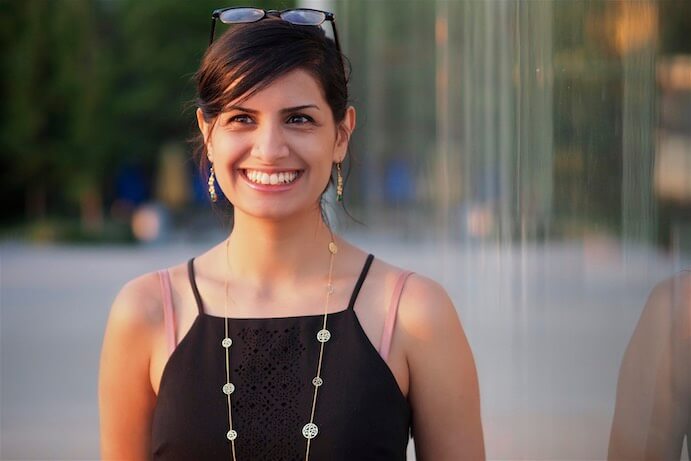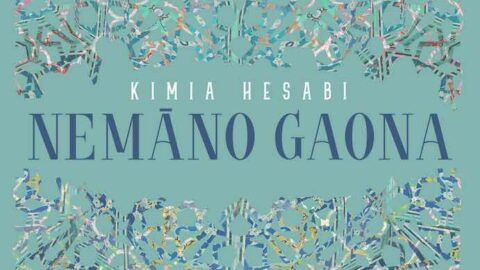In the ancient Iranian language Avestan, “Nemāno Gaona” translates to “colors of home.” On her debut album of the same name, Iranian violist Kimia Hesabi performs seven works that uniquely represent the disparate and intersecting qualities of contemporary classical music and Iranian folk traditions. For Hesabi, founder of the Yasna Ensemble and a current resident of Washington, D.C., these works by composers of the Iranian diaspora signify developments of music in Iran, as well as Iranian music abroad.
Gity Razaz’s Song and Whispers primarily explores two different sound worlds: melodic “song” traditions in Iranian music and contemporary classical “whispers.” At first, the piece seems to juxtapose both ideas with little interaction, but both techniques are welded into a new and unexpected musical language by the end. In that sense, Song and Whispers functions as a statement of musical purpose: finding the common denominators between ancient musical traditions and new ones, and opportunities where there aren’t any preexisting common threads, creating them from scratch.
Hesabi’s program notes for Alireza Mashayekhi‘s Variant op. 139, no. 2 state that the work starts with “an uncomplicated motif, suggesting the sort of thematic development used in an āvāz,” a modal vocal passage in Persian music. But to an ear unfamiliar with Persian traditions, this kind of thematic development also resembles techniques used in classical music. This is not to imply a direct cultural exchange, but to emphasize that if the mission of Nemāno Gaona is the marriage of musical traditions, then Variant meets those parameters.

The word “kamalto” is a portmanteau of “kamancheh” (an Iranian bowed instrument) and “alto” (French for viola). In Showan Tavakol’s Kamalto, the viola is meant to represent the sound of a kamancheh. The first movement, sung by Lori Şen, is based on a text by the ancient Persian poet Rumi. The movement is structurally a call and response, featuring sung stanzas separated by long tones from the viola. When the viola part becomes busier, the vocalist’s return is signaled by long tones. In the second movement, the solo viola plays the role of both soloist and accompanist, with technically difficult passages interrupted by sustained tones.
Among the composers across Nemāno Gaona, Bahar Royaee is perhaps the least concerned with making explicit musical references. Tombstone is an exploration of timbre that makes for an effective transition out of Kamalto. The work is based on a collection of poems by Yadollah Royaee — Bahar’s late uncle. Each poem in the collection is an imagination of a tombstone for a fictional or real person. Thus the three movements of Tombstone have fairly different emotional arcs and musical characteristics. For a work that eschews the use of melody in any traditional sense, Tombstone is one of the most emotionally striking pieces on the album.
Veiled, by Niloufar Nourbakhsh, focuses on the 2017 Tehran protests against the mandatory use of the hijab — a timely inclusion for Hesabi, as the release of Nemāno Gaona (June 17, on New Focus Recordings) predates the current Iranian protests. Nourbakhsh writes that “covered hair is a metaphor in general for women’s presence,” and so the electronic component of the work masks the viola. This description might suggest that the electronics have a menacing quality to them, but in execution, they are quite striking and almost catchy in their own way. The real dramatic tension of the work comes from the viola and electronics fighting for dominance over the musical foreground.

Hani and Sheh Mureed, by Mozhgan Chahian, is based on 15th-century Balochi folk tales. Chahian explores fewer of the extended techniques and atmospheric soundscapes that define the contemporary classical approaches on the album, but the melodic and lyrical passages throughout the work are no less affecting.
The album closes with Mashayekhi’s Sonata for Viola and Piano. It’s striking to end an album focused on the blending of different musical traditions with something as typical of Western classical music as the sonata. But Mashayekih’s music is only indebted to the form as much as it has to be and wastes no time in building up energy with dissonant textures. The sonata works great as an album closer, as it seems to sum up the common threads of the previous works: There are plenty of contemporary squeals and harmonic scratches, but there are also moments of beautifully composed lyrical passages that reference Iranian folk traditions.
With indisputable craftsmanship, Nemāno Gaona should be considered an important part of the contemporary canon. The concept of the collection — the exploration of Iranian musical traditions within a contemporary classical framework, or vice versa — is effective, interesting, and extremely well done. But divorced from that context, these are works that are intellectually and emotionally effective entirely on their own.
I CARE IF YOU LISTEN is an editorially-independent program of the American Composers Forum, and is made possible thanks to generous donor and institutional support. Opinions expressed are solely those of the author and may not represent the views of ICIYL or ACF.
You can support the work of ICIYL with a tax-deductible gift to ACF. For more on ACF, visit the “At ACF” section or composersforum.org.
























